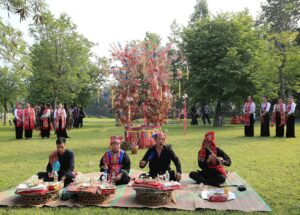The Rain Worshiping Festival Of The Thai People In Muong Lo
To ward off the scorching heat of summer and wish for the arrival of rain so that plants can thrive and crops can grow, ensuring a bountiful harvest and the well-being of the community, people from both the Northern and Southern regions of Vietnam celebrate the Rain Worshipping Festival. However, each region has its unique characteristics, tied to the customs and traditional cultural practices of each locality.
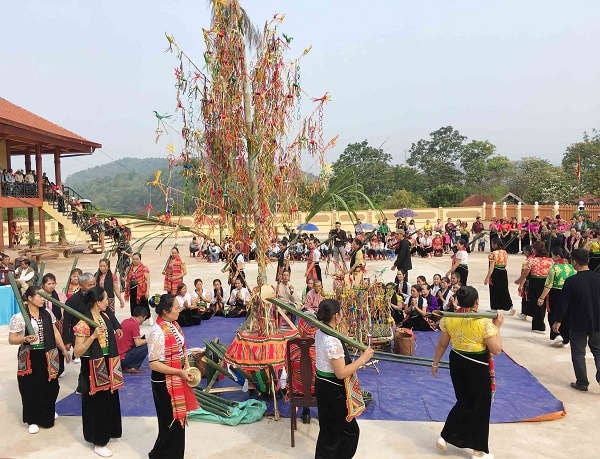
The Deities Who Control Rain and Wind
For the Thai people in the provinces of Dien Bien, Son La, and Lai Chau, the Rain Worshipping Festival (also known as the Xen Xo Phon festival) is held annually around the third lunar month. It is closely tied to the agricultural practices and customs of the Thai people and is considered the most important festival of the year. This festival takes place during the hot and dry period caused by the Lao wind in the Northwest, when the people have more leisure time since the rice cultivation season has not yet reached plowing time (traditionally, the Thai people only cultivated one rice crop during the rainy season), and the old crop has already been harvested by November or December of the previous year. Therefore, this is an ideal time for the Thai people to organize various festivals such as the Xen Ban, Xen Muong, Xen Pang, and the Rain Worshipping Festival.

One month before the festival, the villagers begin preparing offerings consisting of daily foodstuffs such as sticky rice, smoked fish, boiled chicken, glutinous rice, eggs, and bitter bamboo shoots. Particularly, they cannot forget the Van Vat tree, decorated with woven bird and cicada figures, along with bamboo baskets containing chicken eggs, snail shells, clam shells, and local products. The villagers believe that these offerings express their deep respect for the heavens, earth, and deities.
The Ceremony
On the day of the festival, after performing the ritual to ask the earth deity for permission to hold the ceremony at a designated location in the village, the shaman and representatives from both the male and female villagers, dressed in traditional attire, will go from house to house calling everyone to join the festival. Once everyone has been invited, the procession will go to the village’s water source to collect water for the Rain Worshipping Ceremony.
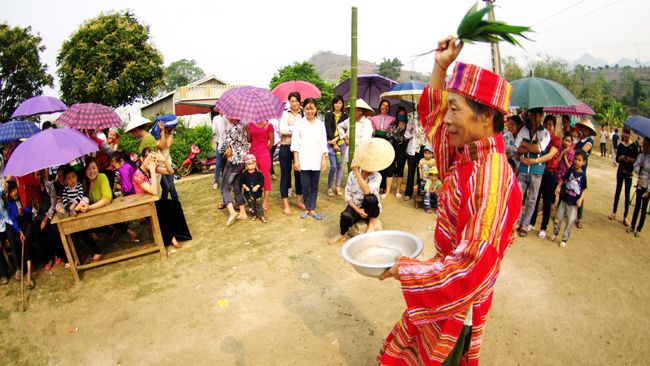
The Festival Rituals
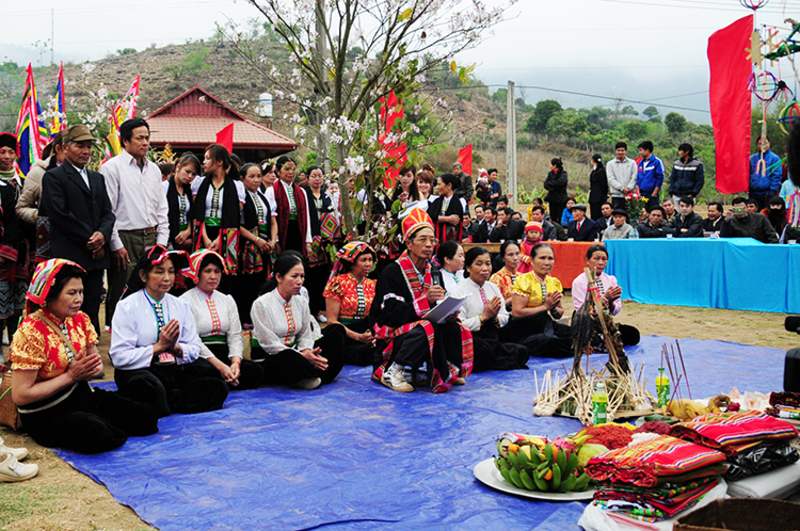
The festival begins when the widows, along with the other women in the village, wear palm leaf hats (called sua cok) and carry baskets to each house to collect donations. They bring with them a bamboo drum (called khe mo) and a basket (called long). When they arrive at each house, they strike the drum to announce their presence and then tap the basket while singing the following chant:
“Du huon bau le?/ Me nang oi?/ Khap tu let hau e/ Khay tu phon hau e/ So nam phon hay ca/ So nam Pha hay na…”
This roughly translates to:
“Is anyone at home, Mother? Please close the doors to the sun for me,
I ask for rain to grow the rice,
I ask for the heavens to bring rain for the fields,
I hope the rice grows quickly,
The crops are withering,
The snails in the fields are dying,
The rice cakes are turning into smoke,
Cassava is rotting in the ground,
There is no place to catch fish,
No food to eat…
The sky is as dark as ink,
The clouds are as dark as ink…”
Depending on the circumstances, some households contribute rice, others contribute wine, cassava, or potatoes, which are placed in the basket before being carried to the ceremony site. The host and the procession will then sing the song:
“Phon phon gio/ Lom lom gio,”
which means:
“Rain quickly,
Wind quickly.”
Once enough offerings have been gathered, the procession will carry a model of the “To ngua” (horse figurine) to the ceremony site. The widow will use the basket as an altar to place the offerings and begin the rain prayer, inviting the rain gods and river gods to partake in the offerings and listen to the villagers’ prayers for rain:
“Moi chau phau tu let muong bun/ Moi chau phau tu phon muong pha/ Moi ma kin chịn mu luong…”
This translates to:
“I invite the god who controls the sun’s gate,
I invite the god who controls the rain’s gate,
Please come and eat the pork as large as a rice pounder…
After eating, I ask for your mercy,
Please close the sun’s gate, and open the rain’s gate.”
The widow organizes a joyful feast for the villagers, where everyone sings and dances to pray for rain. Traditional xoe dances are performed, as it is believed that “without the xoe, the rice won’t grow, and the rice will not flower.”
Later, all villagers, both young men and women, gather near places with water. Together, they splash water on each other while chanting in unison:
“Phon phon gio/ Lom lom gio.”
Unique Aspects of the Thai Rain Worshipping Festival
The most distinctive feature of the Thai people’s Muong Lo Rain Worshipping Festival is the central role of the women, especially widows, in organizing and leading the rituals. In ancient Thai society, women, particularly widows or women with illegitimate children, faced many hardships as they did not have the help of men for heavy labor. The Thai have a saying:
“Viec nang cua con trai, con gai lam khong duoc tha chet,
Viec cua phu nu, con trai khong lam duoc muon khoc.”
This translates to:
“The heavy work of men, daughters cannot do, would rather die;
The work of women, sons cannot do, they would cry.”
Thus, only the widows and women of the village go door-to-door collecting donations and praying for rain, giving special meaning to the action and the prayers made on behalf of these impoverished women, whose wishes are believed to reach the heavens.
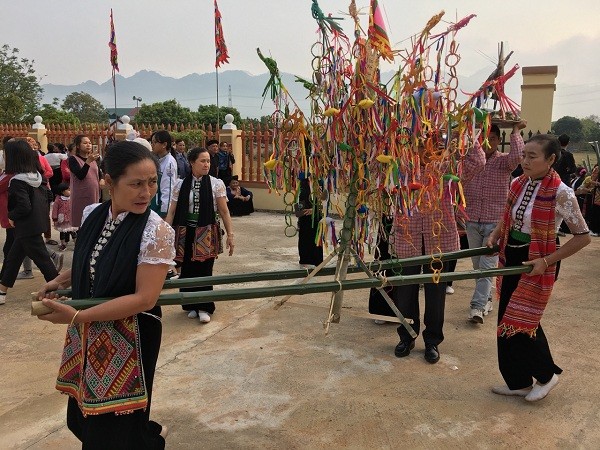
The widow acts as a messenger, carrying the villagers’ rightful wishes to the supernatural beings and also playing the role of a leader. Along with other women, the widow goes door-to-door, calling for unity and awakening the villagers’ enthusiasm, determination, and willpower. It seems that this unity helps create the irrigation systems (muong, phai, lai lin), and the role of women in the matriarchal society of the Thai people is delicately expressed through this compassionate image.
The bamboo drum and the basket are symbolic of the harmony between the forces of nature, representing growth and fertility. The basket, as a small version of the sky, and the sound of the drum symbolize the thunder that signals the arrival of rain. The basket also has deeper symbolic meanings for the Thai people. It is associated with rice, the source of life. Every newborn child is placed in the basket for blessings of quick growth. In the past, couples struggling with infertility would sleep in the basket to help them conceive. When a Thai person passes away, the basket is used to fan the flames during the cremation ceremony. The remains are later placed in the basket before being buried.
Together with the Xen Ban Xen Muong festival, which is dedicated to honoring ancestors and protecting the land of Muong Lo, the Rain Praying Festival is an essential cultural and spiritual activity for the community.
